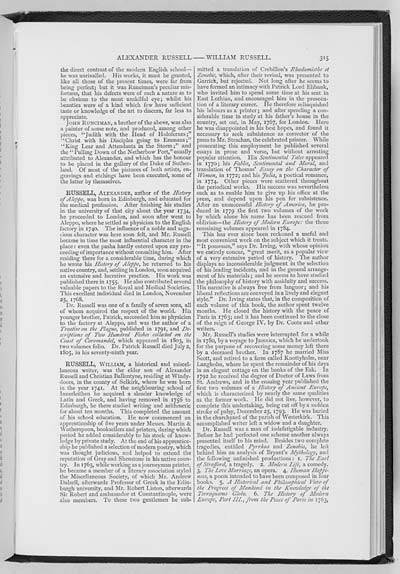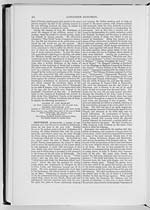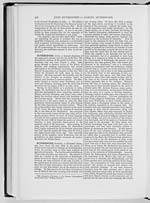Volume 3 > Half-Volume 5
(328) Page 315 - Russell, Alexander
Download files
Individual page:
Thumbnail gallery: Grid view | List view

3i5 the direct contrast of the modern English school� he was unrivalled. His works, it must be granted, like all those of the present times, were far from being perfect; but it was Runciman's peculiar mis- fortune, that his defects were of such a nature as to be obvious to the most unskilful eyej whilst his beauties were of a kind which few have sufficient taste or knowledge of the art to discern, far less to appreciate. JOHN RUNCIMAN, a brother of the above, was also a painter of some note, and produced, among other pieces, "Judith with the Head of Holofernes;" "Christ with his Disciples going to Emmaus;" "King Lear and Attendants in the Storm;" and the "Pulling Down of the Netherbow Port, "usually attributed to Alexander, and which has the honour to be placed in the gallery of the Duke of Suther- land. Of most of the pictures of both artists, en- gravings and etchings have been executed, some of the latter by themselves. RUSSELL, ALEXANDER, author of the History of Aleppo, was born in Edinburgh, and educated for the medical profession. After finishing his studies in the university of that city about the year 1734, he proceeded to London, and soon after went to Aleppo, where he settled as physician to the English factory in 1740. The influence of a noble and saga- cious character was here soon felt, and Mr. Russell became in time the most influential character in the place: even the pasha hardly entered upon any pro- ceeding of importance without consulting him. After residing there for a considerable time, during which he wrote his History of Aleppo, he returned to his native country, and, settling in London, soon acquired an extensive and lucrative practice. His work was published there in 1755. He also contributed several valuable papers to the Royal and Medical Societies. This excellent individual died in London, November 25, 1768. Dr. Russell was one of a family of seven sons, all of whom acquired the respect of the world. His younger brother, Patrick, succeeded him as physician to the factory at Aleppo, and was the author of a Treatise on the Plague, published in I791 and De- scriptions of Two Hundred Fishes collected on the Coast of Coromandel, which appeared in 1803, in two volumes folio. Dr. Patrick Russell died July 2, 1805, in his seventy-ninth year. RUSSELL, WILLIAM, a historical and miscel- laneous writer, was the elder son of Alexander Russell and Christian Ballantyne, residing at Windy- doors, in the county of Selkirk, where he was born in the year 1741. At the neighbouring school of Tnnerleithen he acquired a slender knowledge of Latin and Greek, and having removed in 1756 to Edinburgh, he there studied writing and arithmetic for about ten months. This completed the amount of his school education. He now commenced an apprenticeship of five years under Messrs. Martin & Wotherspoon, booksellers and printers, during which period he added considerably to his stock of know- ledge by private study. At the end of his apprentice- ship he published a selection of modern poetry, which was thought judicious, and helped to extend the reputation of Gray and Shenstone in his native coun- try. In 1763, while working as a journeyman printer, he became a member of a literary association styled the Miscellaneous Society, of which Mr. Andrew Dalzell, afterwards Professor of Greek in the Edin- burgh university, and Mr. Robert Liston, afterwards Sir Robert and ambassador at Constantinople, were also members. To these two gentlemen he sub- mitted a translation of Crebillon's Rhadamisthe et Zenobie, which, after their revisal, was presented to Garrick, but rejected. Not long after he seems to have formed an intimacy with Patrick Lord Elibank, who invited him to spend some time at his seat in East Lothian, and encouraged him in the prosecu- tion of a literary career. He therefore relinquished his labours as a printer; and after spending a con- siderable time in study at his father's house in the country, set out, in May, 1767, for London. Here he was disappointed in his best hopes, and found it necessary to seek subsistence as corrector of the press to Mr. Strachan, the celebrated printer. While prosecuting this employment he published several essays in prose and verse, but without arresting popular attention. His Sentimental Tales appeared in 1770; his Fables, Sentimental and Moral, and translation of Thomas' Essay on the Character of Women, in 1772; and his Julia, a poetical romance, in 1774. Other pieces were scattered throughout the periodical works. His success was nevertheless such as to enable him to give up his office at the press, and depend upon his pen for subsistence. After an unsuccessful History of America, he pro- duced in 1779 first two volumes of the work by which alone his name has been rescued from oblivion�the History of Modern Europe: the three remaining volumes appeared in 1784. This has ever since been reckoned a useful and most convenient work on the subject which it treats, "It possesses," says Dr. Irving, with whose opinion we entirely concur, "great merit, as a popular view of a very extensive period of history. The author displays no inconsiderable judgment in the selection of his leading incidents, and in the general arrange- ment of his materials; and he seems to have studied the philosophy of history with assiduity and success. His narrative is always free from languor; and his liberal reflections are conveyed in a lively and elegant style." Dr. Irving states that, in the composition of each volume of this book, the author spent twelve months. He closed the history with the peace of Paris in 1763; and it has been continued to the close of the reign of George IV. by Dr. Coote and other writers. Mr. Russell's studies were interrupted for a while in 1780, by a voyage to Jamaica, which he undertook for the purpose of recovering some money left there by a deceased brother. In 1787 he married Miss Scott, and retired to a farm called Knottyholm, near Langholm, where he spent the remainder of his days in an elegant cottage on the banks of the Esk. In 1792 he received the degree of Doctor of Laws from St. Andrews, and in the ensuing year published the first two volumes of a History of Ancient Europe, which is characterized by nearly the same qualities as the former work. He did not live, however, to complete this undertaking, being cut off by a sudden stroke of palsy, December 25, 1793. He was buried in the churchyard of the parish of Westerkirk. This accomplished writer left a widow and a daughter. Dr. Russell was a man of indefatigable industry. Before he had perfected one scheme another always presented itself to his mind. Besides two complete tragedies, entitled Pyrrhus and Zenobia, he left behind him an analysis of Bryant's Mythology, and the following unfinished productions : I. The Earl of Strafford, a tragedy. 2. Modern Life, a comedy. 3. The Love Marriage, an opera. 4. Human Happi- ness, a poem intended to have been composed in four books. 5. -A Historical and Philosophical View of the Progress of Mankind in the Knowledge of the Terraqueous Globe. 6. The History of Modern Europe, Part III., from the Peace of Paris in 1763,
Set display mode to:
![]() Universal Viewer |
Universal Viewer | ![]() Mirador |
Large image | Transcription
Mirador |
Large image | Transcription
Images and transcriptions on this page, including medium image downloads, may be used under the Creative Commons Attribution 4.0 International Licence unless otherwise stated. ![]()
| Biographical dictionary of eminent Scotsmen > Volume 3 > Half-Volume 5 > (328) Page 315 - Russell, Alexander |
|---|
| Description | Spine title: Half-Vol. V. Macadam to Smith. |
|---|---|
| Description | Volume III. Contains names alphabetically from Macadam to Young. |
|---|

